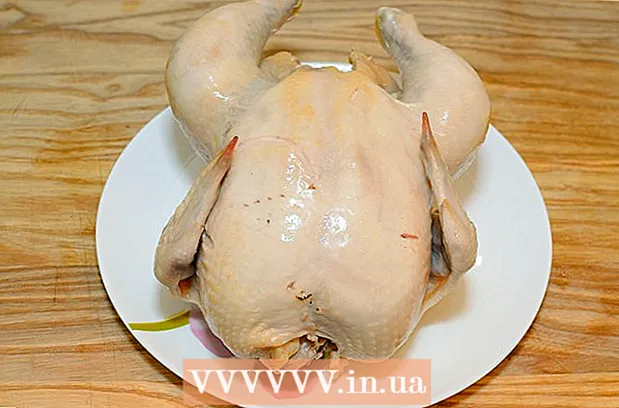Author:
Eric Farmer
Date Of Creation:
8 March 2021
Update Date:
27 June 2024

Content
- Steps
- Method 1 of 4: Selecting and Preparing Tulips
- Method 2 of 4: Bouquet of tulips
- Method 3 of 4: Arranging tulips one at a time
- Method 4 of 4: Caring for your tulips
- Warnings
- What do you need
A properly selected bouquet of tulips can decorate any room. When composing it, you will need to choose the color of the tulips, the size of the bouquet and the type of container in which you want to put it. If properly cared for, tulips will delight you for more than a week.
Steps
Method 1 of 4: Selecting and Preparing Tulips
 1 Decide how many tulips to buy. The amount depends on the composition you want to compose. A large bouquet requires 9 or 11 flowers (if you are not superstitious, you can take a dozen), for a small one, 3 or 5. You can put tulips one at a time.
1 Decide how many tulips to buy. The amount depends on the composition you want to compose. A large bouquet requires 9 or 11 flowers (if you are not superstitious, you can take a dozen), for a small one, 3 or 5. You can put tulips one at a time. - It is also good to imagine before buying which vase or other vessel you plan to put tulips in. Ideally, their stems should fit tightly enough into the neck of the vase, but not be tightly compressed.
 2 Choose a color. Tulips come in a wide variety of colors, and your bouquet can include one color or several.
2 Choose a color. Tulips come in a wide variety of colors, and your bouquet can include one color or several. - To decorate an interior with flowers, people usually choose them based on the color scheme of the room. You can use tulips in the same shade as the other accent colors in the room, or add contrast. For example, red tulips can look beautiful in a room with red couch cushions and neutral walls. On the other hand, bright orange tulips will create a dramatic contrasting burst of complementary color in a room decorated exclusively in shades of blue.
- Another option is to choose a color based on its meaning. In the language of flowers, tulips of each color carry their own special, slightly different message.
- Red tulips speak of love and mean: "Please believe me."
- Yellow tulips used to mean unrequited love, but now they say: "Your smile shines like the sun" (however, some consider yellow flowers unlucky).
- White tulips can symbolize forgiveness, bliss, newness and purity.
- Cream tulips say, "I will love you forever."
- Purple tulips symbolize wealth and greatness.
- Pink tulips symbolize deep affection.
- Orange tulips represent energy, desire and passion.
- Multicolored tulips say, "You have beautiful eyes."
 3 Choose tulips that have not yet opened. The bouquet will last longer if you choose unopened buds that have just begun to show their color - just long enough for you to determine which color you are buying.
3 Choose tulips that have not yet opened. The bouquet will last longer if you choose unopened buds that have just begun to show their color - just long enough for you to determine which color you are buying. - Tulips that have already begun to open will last beautifully for a day or two, but since they are at a later stage in their life cycle, such a bouquet will not last long.
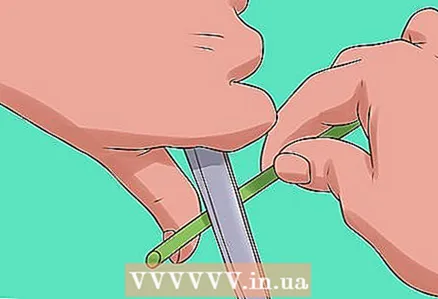 4 Trim the stems under running water. Use a clean, sharp knife to cut the bottom 1.3–2.5 cm of each stem. Cut diagonally so that the stems can absorb more water.
4 Trim the stems under running water. Use a clean, sharp knife to cut the bottom 1.3–2.5 cm of each stem. Cut diagonally so that the stems can absorb more water. - When the stems dry out, their capillaries gradually close, limiting the flowers' ability to receive water. A fresh cut will open the capillaries again, making it easier for the tulips to “drink”.
- You can prune tulips by spreading them out on a horizontal surface, but it is recommended to do this in running water or in a container of water so that air does not get on the cut and does not clog the capillaries in the stem through which the flower receives water.
 5 Remove most of the leaves. At a minimum, you need to remove the bottom leaf from each stem. If you wish, you can remove more leaves to change the look of your bouquet.
5 Remove most of the leaves. At a minimum, you need to remove the bottom leaf from each stem. If you wish, you can remove more leaves to change the look of your bouquet. - In a medium to large bouquet, usually only the top leaf is left on each stem. This is enough to give a bouquet of greenery and volume, making it lush. Excess leaves will distract attention from the flowers.
- Check for dirt on the leaves you leave behind. Wipe off or wash off any debris that may be on the inside of the sheet.
- To remove the leaves, simply pull each leaf back and gently peel it off the stem, like a peel.
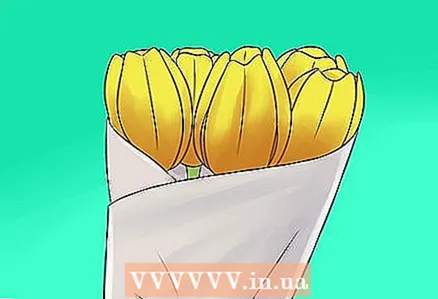 6 Straighten the tulips. Before making a bouquet, it is a good idea to prepare the stems so that they are strong and straight.
6 Straighten the tulips. Before making a bouquet, it is a good idea to prepare the stems so that they are strong and straight. - Wrap all tulips in folded newspaper or brown paper. The top edge of the paper should be above the tops of the tulips, and about a third of the length of the stems should remain open at the bottom.
- Place the wrapped bouquet in a clean container of cold water. There should be enough water for all open stems to submerge in it.
- Leave the tulips in this position for an hour or two. Then take them out of the paper and arrange them as you wish.
- Keep in mind that you can repeat this procedure periodically as soon as the tulips in the bouquet begin to droop.
Method 2 of 4: Bouquet of tulips
 1 Select a capacity. Tulips look great in a wide variety of vessels. You can use a traditional vase or experiment with a container for another purpose.
1 Select a capacity. Tulips look great in a wide variety of vessels. You can use a traditional vase or experiment with a container for another purpose. - When choosing a container, one must take into account the size. Large compositions work best in tall and wide containers, while small or narrow containers are more suitable for small ones.
- You can use a crystal, metal or ceramic vase.
- If you want to make a country-style bouquet, use a container that was not originally intended for flowers. Suitable options are large glass jars, cans, jugs, teapots, and plastic glasses.
 2 Wash the container. Wash the selected vessel with hot water and detergent, then rinse thoroughly to avoid leaving any residue.
2 Wash the container. Wash the selected vessel with hot water and detergent, then rinse thoroughly to avoid leaving any residue. - Bacteria can significantly shorten the lifespan of cut tulips, so starting with a clean container is essential if you want the flowers to last for several days.
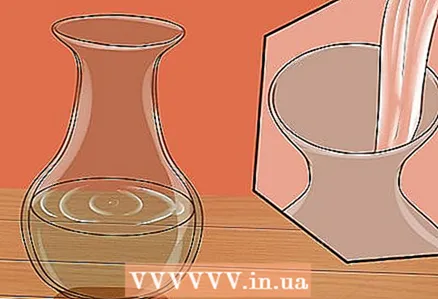 3 Pour in lukewarm water. Fill the container about three-quarters with cool to lukewarm water.
3 Pour in lukewarm water. Fill the container about three-quarters with cool to lukewarm water. - The stems suck up cool water more easily than ice cold water, so room temperature water is best if you want to keep your tulips healthy.
 4 If necessary, trim the tulips to the desired height. For most compositions, they should be pruned so that about one third of the stem height is above the vase.
4 If necessary, trim the tulips to the desired height. For most compositions, they should be pruned so that about one third of the stem height is above the vase. - This height allows for the natural curvature of the stem.
- For large bouquets, about 13 cm of the stem is usually left above the rim of the vessel. For medium and small, you should leave about 10 cm.
- As before, trim the stems under running water with a clean, sharp knife.
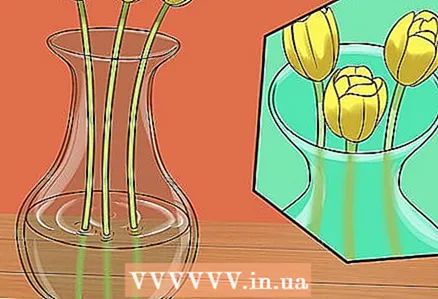 5 Arrange flowers around the edge of the bouquet. Place two-thirds to three-quarters of your tulips around the perimeter of the vessel.
5 Arrange flowers around the edge of the bouquet. Place two-thirds to three-quarters of your tulips around the perimeter of the vessel. - You can arrange the stems vertically, or have them crisscross inside the container, forming a net that will hold them in place. In the first case, the tulips will stand upright, in the second, they will tilt outward.
 6 Fill in the middle. With the remaining tulips, fill in the free space in the center of the bouquet. Try to keep the same distance between them.
6 Fill in the middle. With the remaining tulips, fill in the free space in the center of the bouquet. Try to keep the same distance between them. - If the outer tulips are inclined, the center ones should also be placed at a slight angle.
- Likewise, if the tulips are straight at the edges, they should also be placed vertically in the middle.
 7 Rotate the bouquet. If you are standing upright, grab the bouquet just above the rim of the container with both hands and turn the tops of the stems slightly to one side.
7 Rotate the bouquet. If you are standing upright, grab the bouquet just above the rim of the container with both hands and turn the tops of the stems slightly to one side. - As a result, the bouquet will open slightly like a fan, but the stems will not bend. The effect will not be as noticeable as when crossing stems, however, the load on the stems will be lower.
Method 3 of 4: Arranging tulips one at a time
 1 Select a capacity. There are many ways to beautifully position a single tulip, but the vessel must be either very narrow or very low.
1 Select a capacity. There are many ways to beautifully position a single tulip, but the vessel must be either very narrow or very low. - A single flower vase will work well as a more traditional option, or you can choose a tall and narrow cylindrical vase that is taller than the tulip itself. The vase should be narrow enough so that the flower stays in place rather than dangling inside it.
- Narrow-necked bottles are a good choice if you are leaning towards a rustic country style. In this case, teacups, baby food jars, or small tin cans are also fine.
 2 Wash the container thoroughly. Use hot water and detergent to clean any traces of dirt and debris from the selected container. Rinse it off with clean running water to remove any remaining detergent.
2 Wash the container thoroughly. Use hot water and detergent to clean any traces of dirt and debris from the selected container. Rinse it off with clean running water to remove any remaining detergent. - If bacteria are in the vase or in the water, tulips will wilt much faster than in a clean vase.
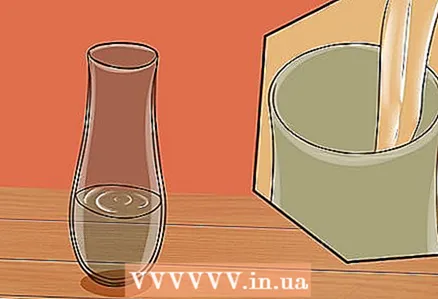 3 Fill the container with water. Pour enough water into the vessel so that half to three-quarters of the stem's height is immersed in it.
3 Fill the container with water. Pour enough water into the vessel so that half to three-quarters of the stem's height is immersed in it. - How much you need to fill the vessel also depends on its height.
- In tall, narrow containers, the water should cover about three-quarters of the stem's height.
- A low and wide vessel may not be so high, but still try to keep at least half of the stem submerged in water and the flower does not suffer from dehydration.
- Use lukewarm water, as it is easier for tulips to “drink” it than ice water.
- How much you need to fill the vessel also depends on its height.
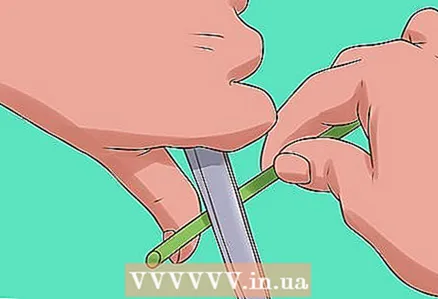 4 Trim the stem back if necessary. The stem length of your tulip will depend on the vessel used.
4 Trim the stem back if necessary. The stem length of your tulip will depend on the vessel used. - When you use a tall, narrow vessel that fits the whole tulip, the long stem looks more attractive than the short one. The tulip should end below the rim, but there should not be too much empty glass above it.
- If you are using a standard narrow-necked vase for one flower, there should be two-thirds to three-fourths of the stem inside the vase.
- If you are using a wide and low vessel, its depth should be at least half the height of the tulip stem.
 5 Place a tulip. Place the flower in the vessel and touch up.
5 Place a tulip. Place the flower in the vessel and touch up. - Tulips always lean a little, but this slope should be minimal if the flower is in a tall and narrow vase.
- When placing the tulip in a wide and low vessel, position it so that the stem runs diagonally to the opposite side of the bottom. The soft stem will slightly droop, but this is usually taken into account as a special feature of the composition.
Method 4 of 4: Caring for your tulips
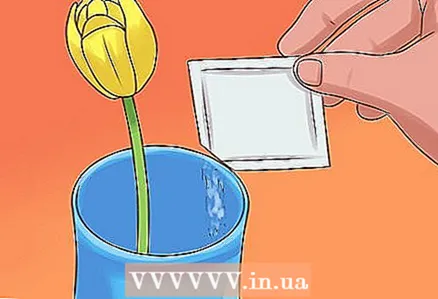 1 You can add top dressing. There is no consensus on how effective top dressing is for cut tulips. Some people think tulips don't need it, but there is no evidence that it can harm flowers, which means you can add it as a preventative measure if you want.
1 You can add top dressing. There is no consensus on how effective top dressing is for cut tulips. Some people think tulips don't need it, but there is no evidence that it can harm flowers, which means you can add it as a preventative measure if you want. - You can buy flower food at your flower shop. You can buy it right away along with the tulips.
- Pour the dressing into the water and let it dissolve, then place the tulips. Add top dressing every time you change the water.
 2 Keep tulips away from heat sources. These include direct sunlight, radiators, stoves, lamps, and televisions.
2 Keep tulips away from heat sources. These include direct sunlight, radiators, stoves, lamps, and televisions. - Under the influence of hot air, tulips will pass their life cycle faster. As a result, the bouquet will not last as long as it could in other conditions.
 3 Add water. Tulips drink a lot, so check the water level twice a day and add water at least once a day.
3 Add water. Tulips drink a lot, so check the water level twice a day and add water at least once a day. - To improve the condition of tulips, it is wise to completely change the water every three to four days. Change the water as soon as it begins to cloud to prevent bacteria from multiplying. This will extend the life of your flowers.
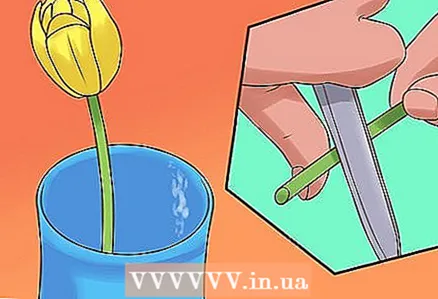 4 Prune every few days. Each time you change the water, trim the stems about half a centimeter with a clean, sharp knife.
4 Prune every few days. Each time you change the water, trim the stems about half a centimeter with a clean, sharp knife. - Regular trimming of the tips will remove the part of the stem that has begun to deteriorate and unblock the capillaries located above. As a result, the stem will absorb water more easily and the tulips will live longer.
- When pruning the stems, keep them submerged in water.
Warnings
- Don't mix tulips with daffodils. They secrete sap, which can clog the capillaries in the stems of tulips, causing them to wilt quickly. If you really want to combine these flowers in a composition, keep the daffodils in a separate vase for a day and only then put them in clean water along with the tulips.
What do you need
- 1 to 11 tulips
- Clean sharp knife or scissors
- Newspaper
- Water
- Detergent
- Vase or other vessel
- Cut flower feed (optional)



